Part 5 of the Christmas Movie Watchstravaganza
Almost Christmas
Dolly Parton’s Christmas on the Square
It’s a Wonderful Life
The Life and Adventures of Santa Claus
The Polar Express
Wikipedia states that the book this movie adapts “was praised for its…calm, relaxing storyline.”
I have no clue what happened to that.
There are several Christmas movies and specials that I like, but few I have a longtime attachment to. As a kid, mostly I watched them with glassy eyes the way I watched most things. But I first watched The Polar Express in a cool hotel room that came with a mini-fridge stocked with interesting candy. It was a novelty to order movies and video games on demand through the hotel TV. So Mom rented Sky High (which kind of sucked and was instantly forgotten) along with this film.
I don’t think I was jumping up and down when I saw it, but I did think, “This is pretty good.” And forever after, I would remember it thinking, “Hey, that film was pretty good.”
How dare a cursory web search pull up a 6.6/10 IMDb score and a 55% Rotten Tomatoes score. What, do these people just hate motion capture? Do they like taking shots of these movie children out of context and calling them “the creepiest film kids of all time”? Do they just have no respect for the child on the tape loop who says “I didn’t do it” and then my sibling remembered that for ages but couldn’t recall where it was from until, finally, the homecoming?
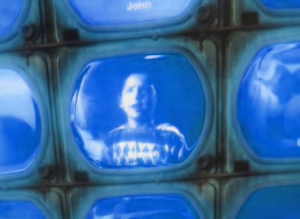
Shame on them! I will prove why this film is the greatest.
First, a Quick Question: How Many Kids REALLY Believe in Santa?
Because I can’t remember ever thinking consciously about the subject, or ever hoping Santa Claus would really come to my home. Well, actually, once when I was seven on Christmas Eve, I watched my mother and uncle setting up the tree. I believe they’d already set gifts out, because I asked myself blandly, “Is Santa coming? No, I guess not. I guess he’s not real.” But the fact that my loving family members were getting me gifts—not only this time but every time—was more than enough to satisfy me.
If Santa Claus is a magical crutch to give kids a “fun way” to put faith in Jesus Christ, then…I’m confused as to why that would be considered necessary or valuable.
Oh! Yeah, I just remembered Santa’s used to sell tons of products. Never mind! Solved that mystery.

Anyway, The Polar Express opens on a child in his room on Christmas Eve. We’ll call his Thomas just for convenience. He’s not planning on sleeping tonight because he’s determined to hear the bells of Santa’s sleigh. But he’s having a crisis of faith because now he’s eight years old—on the cusp of when, it seems, many kids stop believing in Santa.
He checks the news clippings. He checks the encyclopedia. He looks through pictures of defrauded Santas who were dads in disguise. Will Santa really come?
Well, someone else does. The boy’s clock stops. His toy airplane goes wild. And a huge, rumbling train has stopped outside his front door. He just got a visit from the conductor of the Polar Express.
You know the stakes of this movie are already huge, right? I have a theory that for a bunch of kids raised in Christian families in the United States (kids from my generation and somewhat older), labelling something as a Christmas special or somehow Santa-related somehow exalts it. It gives it an air of importance and mystery, of instant importance. First of all, a televised holiday special only comes on once a year; after Christmas, it’s not rerunning. Second, the United States is downright Christmas-philic, in a way that might not be healthy.
Endless Christmas-themed commercials, advent calendars and themed candies in stores, wintery school projects, and, for some, the famed “snow day”—it all piles on top of that ultimate hedonistic kid experience of receiving fun toys under the tree.
All that coupled with the tension this movie is mounting on Doubting Thomas’s struggle to believe in Santa jacks it up high. It will only get more stressful from here.
Tom is invited by Tom (Tom Hanks, playing a hardass-yet-wacky conductor) to come aboard and ride to the North Pole. But will the boy really meet…a certain someone?
He hesitantly boards, and now we have four key characters: an eternal skeptic, a pink-wearing Black girl with excellent leadership skills and no relevant flaws, a kid in yellow who likes science fiction and whom everybody wishes would shut up, and the conductor, their mysterious supernatural leader.

In some ways, this movie is just Willy Wonka and the Chocolate Factory except on a train and limited to Christmas. Both movies exploit a common hedonistic desire children have (eating chocolate, getting toys), up the stakes to world-shaking status (with an in-universe global competition and the existing mythos of Santa), and have a bunch of counterplay between the kid characters and the chief authority figure, who at first looks like a weirdo hardass but eventually proves to have a melting heart.
In The Polar Express’s case, the conductor starts as an adversary. He commands the disorderly kids to sit in their seats. He won’t stop the train so the kid from “the other side of the tracks” can get on. He asks for Pink Girl’s ticket (which is incidentally golden), but she’s misplaced it, so Thomas has to go on the wildest of wild goose chases to get it.
Critically, though, every point of tension is shatteringly dramatic. If anything goes wrong, Thomas won’t be able to go see Santa—and according to the thesis of this film, that’s, like, the most important thing ever! If he pulls the emergency brake to help that kid, he might get his own seat revoked!
But something else also raises the tension: the constant danger this little dude gets into.
Within minutes of boarding, he’s facing an icy death by leaping huge gaps between train cars in an arctic snowscape. Yes, he leaps full feet from car to car in his attempt to return Pink Girl’s lost ticket (which, just so you know, earlier he accidentally dropped in the wind, where it settled in the snow, where a pack of wolves kicked it up into the air, where an eagle nabbed it, where its chick attempted to chew it and spat it up…and long story short, it magically found its way back, after proving that continuous CG tracking shots have some interesting creative uses).
About ten seconds after that, Thomas is on top of the train marching through dense snow without handholds, and somehow doesn’t lose his balance once. He meets a ghost hobo who, weirdly, doesn’t seem to believe in Santa despite being a supernatural being many people don’t believe in himself, and knowing it. Then Thomas and the strange hobo are skiing together down the whole train so they can avoid being crushed to death by a very small tunnel mouth.
Besides the mere fact that there is a train in this movie, there’s nothing calm or relaxing about this at all.
As far as I can tell, being someone who’s never read the original book, if you wanted to do a straight animated adaption of that, you’d rather make a short film, The Snowman-style. It would be thirty minutes at absolute max. There wouldn’t even be any of the crisis-of-faith stuff.
You also wouldn’t make the two dudes in the engine room a large bald man and a twiggy beard man who are constantly rattling off zany banter. The twiggy beard man probably wouldn’t yodel like a caribou when his beard is pulled either.
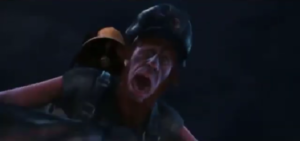

A horrible string of near-calamities happens. Worse (for Thomas and his nerves; better, maybe, for the captive audience), some of it is for naught. He finally catches up to Pink Girl, only to discover that when the conductor learned she didn’t have her ticket on her, he…promoted her to drive as an engineer! Well, gee, that’s convenient. Of course, I say that now, but as a kid I just thought, “Woah, this engine room is a cool new location and it’s kind of dreamlike.” (Dreaminess is another quality I latched onto whenever I saw it.)
So now the ticket Thomas is holding kinda doesn’t matter, and instead he has to keep the train from crashing horribly into the millions of caribou crowding the tracks. Strangely, Thomas never suffers a fatal stress-induced heart attack.
Luckily, no caribou die, and Beard Man’s horrific yodels of beard-tugging pain drives them off. The conductor, now an ally, congratulates the kids on a job well done, changing the dynamic of the characters. We sacrifice the heart of the cast and the most engaging things about them (the “when the cat’s away, the mice will play” aspect of the conductor vs. these mystified kids) for, mostly, set pieces.
The train tracks are sealed under the ice! The ice is breaking, plunging the lower half of the cars under hypothermia water! They’ve gotta drive into this sweet spot by barking “left” and “right” at the beard man and the bald man while they drive! But also they can’t stop the train because the pin that helps them stop the train flew off the train and bounced around and it hit the bald guy and it hit the beard guy and it flew into the bald guy’s mouth and he spit it out then he swallowed again so at last they remembered there’s another pin just like it underneath the beard guy’s hat.
Eventually the film takes a real, legitimate breath as the train, safe and sound after Tokyo-Double-Drifting across the North Pole and burning rubber (or metal, whatever trains have), they’re spiraling calmly up a moonlit peak. And on the other side is a bridge to Santa’s city, where he and the elves await.
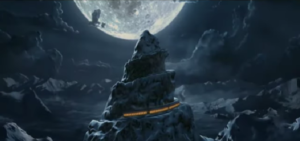
But don’t you fret. The tension is going to mount again. After all, the Big Man and his climax are just ahead!
Now, the poor kid from the other side of the tracks (Billy) and the annoying kid (I just call him “Mandark” because that’s his voice actor, and yes, the voice is so cartoony it’s out of place in his motion-capture mouth) have had some presence throughout. They’re part of our main cast too, after all. But due to train shenanigans, Thomas has been spending most of his time with Pink Girl. Which is fine, because the engine room dudes are already annoying and odd and we don’t want to compound that too much.
The only major thing, though, is that at some point Billy was singing some random Christmas song, and Pink Girl joined in. This makes no sense because he wasn’t singing a Christmas classic or anything, just a generic song made for this movie, so how could Pink Girl possibly have known the words to join in? But…I’m no Mandark, I’m not a pedant. Not always. This song is just a symbolic way for Pink Girl to reach out and connect.
I think Billy’s character arc is supposed to be that, since he’s poor and never celebrated a Christmas filled with presents and capitalist fun before, he believes that he doesn’t “deserve” a Christmas or to board the Polar Express in the first place. I think that needs to be clearer, though. If I’m not 100% sure of his motivations and I’m some blog-adult, wouldn’t people half my age and under need more clarification? Or am I just a big dummy-dum?
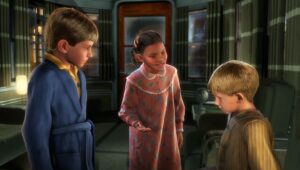
Well, Thomas and Pink Girl have gone through hell and high water just to get this boy to see Santa and fulfill his dreams. And they’re STILL going through it even after he’s duetted with Pink Girl and everything! I can’t find it in even my withered aged heart to dislike Billy, since he’s just a non-malicious child who seems to be the youngest and most lost of any of them, but he’s really pushing it, and he’s gonna push it even more.
Long story short, Thomas and Pink Girl try to get Billy out of the caboose but they accidentally uncouple it from the rest of the train instead so when they’re supposed to be lining up to see Santa, they actually slide a million miles an hour down tons of inclines and end up in the middle of an utterly empty, utterly cold railway platform with (shiver) festive muzak.
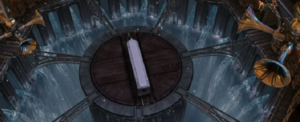
This is terrifying. They’re hundreds of feet above any landmass. There is no way out of this that isn’t death-defying. Either they try to tightrope-walk along those slender train tracks (and fall to their deaths) or they stay and wait for rescue (and starve to death).
The only sound solution is to walk across. Just kidding, neither solution makes sense, but this plan’s failure will lead to quicker results, so I applaud Pink Girl for her quick and decisive thinking on the matter.
They walk, pause, slip, and keep going for minutes on end, and Billy is wearing squeaky rainboots, yet somehow they all survive. After that, they end up in a present-wrapping facility, also empty and muzak’d. And they discover the conveyor belts moving presents toward Santa’s sleigh.
This is Billy’s start of darkness. He finds his gift on the conveyor belt, and at first, you root for him. It’s the proof that Santa really does care about this kid from the other side of the tracks! When he chases after it, you know it’s a temptation that can lead to no good—because you can’t open that until Christmas, silly! But this kid’s eyes are filled with a sorrowful greed. Once he grabs that present, he’s latched on with a death grip. Even when they’re in the thousand-foot-tall bag filled with Santa’s presents for the entire suite of nations, and something’s grabbing his leg, he refuses to release the present and just slap the fucker off! Dude has no patience. Probably because he’s five.
Anyway, Billy, Thomas, Pink Girl, and Yellow Boy (the aforementioned grabby thing) all get sealed up in Santa’s bag by mechanical mechanisms, and the bag is whisked away. Oh no, is this bad?!
Yes and no! They’re soaring over the grand Christmas tree in Santa’s Christmas plaza, which is surrounded by 99.99% elves and 0.01% passengers on the Polar Express. Is the conductor concerned for the safety of those very memorable children who are clearly missing? Nah, I guess by now he just accepts that they’re on a magical adventure guided by the beneficent hand of fate. Likewise, when the bag of presents crashes into the Christmas star on top of the tree, knocking it off so it can slaughter countless elves down below, Tom Hanks doesn’t bat an eye, because he knows that the special parachuting elf-force is going to scoop the star up at the last second. God works in mysterious ways…sorry, I meant Santa.
After all this hullabaloo, the bag is finally set on Santa’s sleigh (looking as comically huge as expected), the children are freed, Billy lets go of his gift and develops a shred of patience, Yellow Boy is given a fraction of a slice of humble pie (which I have to admit is a fairer ending for his arc than tormenting him for shit his parents taught him or let him get away with, Roald Dahl-style), and the moment they’ve all been waiting for is approaching. Thomas will have his doubts resolved! The Big Man is coming out!!

Elves throng around their idol, ducking and diving and standing on each others’ heads just to get a look. Other kids seem to get something out of this, but Thomas can’t find more than the haziest, least satisfying look. He shouts “I can’t see,” but nobody hears.
Then Santa’s reindeer come out. At least they’re easier to make out. Thomas notices that they’re strung up with Christmas bells—that he can’t hear. Pink Girl remarks, “Isn’t that the most beautiful sound?” Thomas remarks “…” because he can’t hear a damn magical thing and now he feels like a fraud.
But, in a slow-motion moment of intense camera-tracking that again seeks to prove motion capture as a useful artistic tool, one of the bells flies up off of the reindeer, bounces around the way a golden pin bounces into a bald man’s mouth, and eventually rolls to Thomas’s feet. He picks it up, shakes it desperately, and then decides to try something new. He says, with determination, “I believe.”
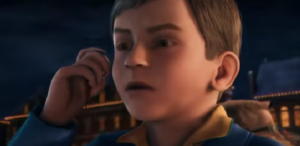
Yay! He can hear the bell. Now, I’m still not sold on Santa Claus as a cultural concept. Does the concept of religious faith really need candy and toys to look “cool enough” for kids? Yet I still think this moment is heartwarming and effective. It’s not powerful because he’s yearning to believe in a guy who gives you toys, or because “Santa is magic and it’s good to believe in magic”; it’s powerful because he’s yearning to believe, surrounded by believers yet distant and stymied. He just can’t get what everyone else is getting, until he makes a conscious and firm decision to “convert.”
It’s a take on one of the many many Christian conversion/crisis-of-faith narratives and a variant of one I’ve heard before, one that strikes me as earnest and relatable. A movie about Santa doesn’t have to go further than that.
Soon Thomas receives another surprise: he is the child chosen to sit on Santa’s lap and tell him the gift he wants the most. Thomas whispers that he’d like that bell from Santa’s sleigh, and he puts it right in his pocket. Unfortunately, the whole audience is sighing and shaking their heads as they would at any Deal or No Deal contestant. He put that bell in his busted pocket with the hole in it!
It’s the end of the world again. When he discovers the loss, he feels that Christmas is ruined again. But he forgot one thing…and no, it’s not the conductor’s bullshit philosophy: “Seeing is believing, but sometimes the truest things are what you don’t see.” You can’t tell that to kids! Especially not Yellow Boy, he’s too literal-minded.
The next morning, though…

Aww, the bell was under the tree after all. Mom and Dad can’t hear it ring, and according to the narration, even Thomas’s little sister would lose her ability to hear its ring as the years went by. But the boy will never doubt again.
Still the Coolest Christmas Film Ever?
Um…uh…no, I never said anything that extreme…
The Polar Express is a good film, a fun film, a genuinely touching and nail-biting film, a memorable 21st-century Christmas movie that I wish had a more indelible pop cultural footprint than Elf (because I dislike Elf. No, actually, I hate Elf). Looking back now, a few elements are forgettable or weak. For example, in my opinion, that car of abandoned toys was a great, poignant idea, but the way they tied it in with the main character’s crisis of faith with that hobo ghost guy (who, by the way, made a striking first impression but appeared way too many times for my liking, eroding the mystery behind him)? Surprisingly not memorable.
But it all rides and dies on the strength of its best scenes in the beginning and the end, and, of course, on the setting: a neat train. This is where Snowpiercer got its cool.
This film could go toe-to-toe with several Rankin/Bass specials—an A-minus or a B-plus in the halls of magical Christmas media. It still warms my heart and puts an excited smile on my face.
Thank you for reading, and Patrons, thank you for Patreonning.
Don’t forget to check out the other Christmas pals I’ve reviewed: Walter Meyers, Dolly Parton, George Bailey, and Santa Claus (the blond one that looks like Link). Or, if you’d like to leave this bizarre Christmas-oriented Bermuda triangle, why not read about those old Blondie movies? You have nothing left to lose.
